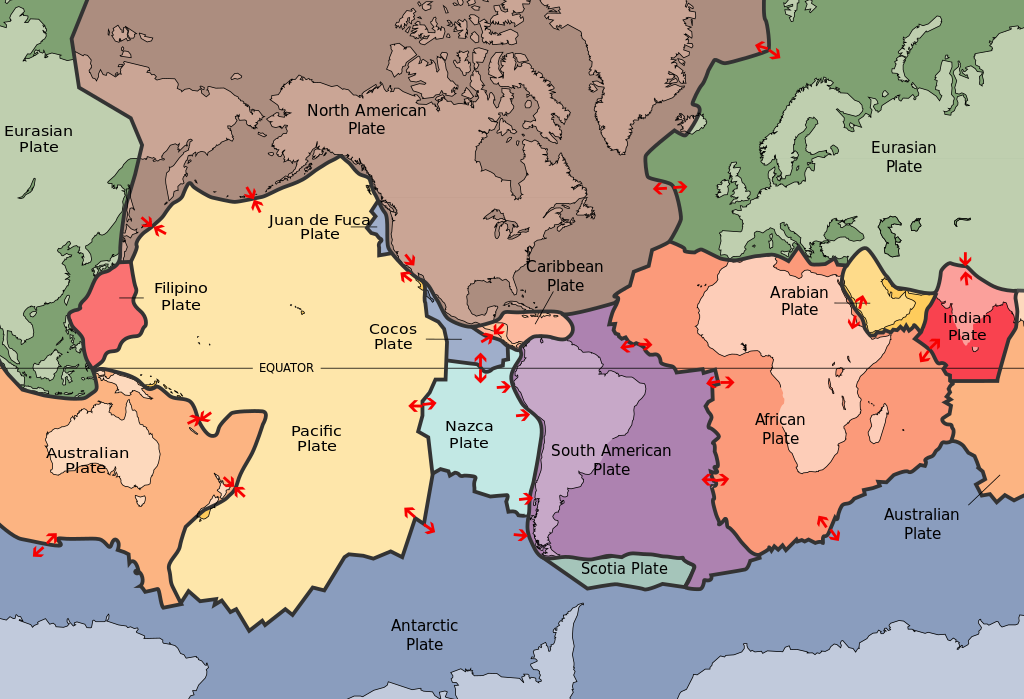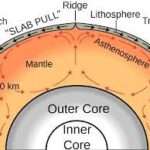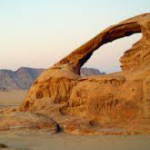What is the Theory of Seafloor Spreading? The theory of seafloor spreading was first proposed by Harold Hemmond Hess in 1960. the two fundamental facts that led him to postulate theory are: (i) the mid-ocean ridge occurs in all major ocean basins, and (ii) the oceanic crust has a thickness of 6 to 7 kilometers only whereas the typical thickness of continental crust is 30-40 km.
Hess postulated that the mid-oceanic ridges are situated over the rising limbs of convection currents of the earth’s mantle and that thin oceanic crust is formed due to the cooling and solidification of lava rising from the mantle. The ocean progressively widens as the new oceanic crust is created along a crack that runs along the crest of mid-oceanic ridges. This mechanism is called “seafloor spreading”. The floor of the Atlantic Ocean has formed by this process during the past 200 million years. The typical rate of spreading at the oceanic ridges has been estimated to be 5.0 cm per year.
The new oceanic crust is created at ridges spreads laterally away and is ultimately destroyed in the oceanic trench systems. The oceanic trenches are the site where convection currents descend down into the mantle. In these areas, the oceanic crust is thrust down into the mantle where it is largely resorbed. Continents are not liable to destruction and hence have a great age. They only passively drift apart floating on convection cells of the mantle.
History of the concept of Seafloor Spreading
Earlier theories presented by Alfred Wegener and Alexander du Toit of continental drift postulated that all the continents in motion “plowed” through the seafloor, which is fixed and immovable. The idea that the seafloor itself moves and also carries the continents with it as it spreads from a central rift axis was proposed by Harold Hammond Hess (commonly known as Harry Hess) from Princeton University and Robert Dietz of the U.S. Naval Electronics Laboratory in San Diego in the 1960s. The phenomenon is known today as plate tectonics. In locations where two plates move apart, at mid-ocean ridges, new seafloor is continually formed during seafloor spreading.
Evidence of Seafloor Spreading
The pieces of evidence, which support the theory of seafloor spreading are as follows.
- Drilling into the ocean floor has been done to study the sediments occurring there. Cores obtained from near the oceanic ridges have sown, that only a thin layer of young sediment overlies the oceanic crust. With an increase in distance from the ridge, the sediments generally thicken, and the age of the sediment also increases.
- Magnetic surveys taken across the oceanic ridges have disclosed symmetrically distributed strips of positive and negative magnet anomalies. The axis of symmetry coincides with the crest of the mid-oceanic ridge. These strips of magnetic anomalies provide proof for the theory of seafloor spreading. At the oceanic ridges new sea floor is being produced. This new seafloor records the reversal in Earth’s magnetic field. The time elapsed between the reversals ranges from thousands to hundreds of thousands of years. By determining the amount of new seafloor produced during a magnetic reversal of known length, the rate of spreading can be calculated.
- The occurrence of earthquakes and active volcanic islands along the crests of mid-oceanic ridges also provide evidence, which is in favor of the theory of seafloor spreading.
Incipience of Sea Floor Spreading
In the general case, seafloor spreading starts as a rift in a continental land mass, similar to the Red Sea-East Africa Rift System today. The process starts by heating at the base of the continental crust which causes it to become more plastic and less dense. Because less dense objects rise in relation to denser objects, the area being heated becomes a broad dome (see isostasy). As the crust bows upward, fractures occur that gradually grow into rifts. The typical rift system consists of three rift arms at approximately 120-degree angles. These areas are named triple junctions and can be found in several places across the world today. The separated margins of the continents evolve to form passive margins. Hess’ theory was that new seafloor is formed when magma is forced upward toward the surface at a mid-ocean ridge.

If spreading continues past the incipient stage described above, two of the rift arms will open while the third arm stops opening and becomes a ‘failed rift’ or aulacogen. As the two active rifts continue to open, eventually the continental crust is attenuated as far as it will stretch. At this point, basaltic oceanic crust and upper mantle lithosphere begins to form between the separating continental fragments. When one of the rifts opens into the existing ocean, the rift system is flooded with seawater and becomes a new sea. The Red Sea is an example of a new arm of the sea. The East African rift was thought to be a failed arm that was opening more slowly than the other two arms, but in 2005 the Ethiopian Afar Geophysical Lithospheric Experiment reported that in the Afar region, September 2005, a 60 km fissure opened as wide as eight meters. During this period of initial flooding, the new sea is sensitive to changes in climate and eustasy. As a result, the new sea will evaporate (partially or completely) several times before the elevation of the rift valley has been lowered to the point that the sea becomes stable. During this period of evaporation, large evaporite deposits will be made in the rift valley. Later these deposits have the potential to become hydrocarbon seals and are of particular interest to petroleum geologists.
Seafloor spreading can stop during the process, but if it continues to the point that the continent is completely severed, then a new ocean basin is created. The Red Sea has not yet completely split Arabia from Africa, but a similar feature can be found on the other side of Africa that has broken completely free. South America once fit into the area of the Niger Delta. The Niger River has formed in the failed rift arm of the triple junction.
Continued Spreading and Subduction
As new seafloor forms and spreads apart from the mid-ocean ridge it slowly cools over time. Older seafloor is, therefore, colder than new seafloor, and older oceanic basins are deeper than new oceanic basins due to isostasy. If the diameter of the earth remains relatively constant despite the production of new crust, a mechanism must exist by which the crust is also destroyed. The destruction of oceanic crust occurs at subduction zones where oceanic crust is forced under either continental crust or oceanic crust. Today, the Atlantic basin is actively spreading at the Mid-Atlantic Ridge. Only a small portion of the oceanic crust produced in the Atlantic is subducted. However, the plates making up the Pacific Ocean are experiencing subduction along many of their boundaries which causes the volcanic activity in what has been termed the Ring of Fire of the Pacific Ocean. The Pacific is also home to one of the world’s most active spreading centers (the East Pacific Rise) with spreading rates of up to 145 ± 4 mm/yr between the Pacific and Nazca plates. The Mid-Atlantic Ridge is a slow-spreading center, while the East Pacific Rise is an example of fast spreading. Spreading centers at slow and intermediate rates exhibit a rift valley while at fast rates an axial high is found within the crustal accretion zone. The differences in spreading rates affect not only the geometries of the ridges but also the geochemistry of the basalts that are produced.

Since the new oceanic basins are shallower than the old oceanic basins, the total capacity of the world’s ocean basins decreases during times of active seafloor spreading. During the opening of the Atlantic Ocean, the sea level was so high that a Western Interior Seaway formed across North America from the Gulf of Mexico to the Arctic Ocean.
Seafloor Spreading proved the Theory of Continental Drift
The theory of continental drift was largely rejected because it postulated that the continents are moving through an unmoving ocean. The concept of seafloor spreading disproves this part of the theory of continental drift. Now that the discovery of the seafloor was made, the possibility of continental motion can be acknowledged. At the Mid-Atlantic Ridge (and in other mid-ocean ridges), material from the upper mantle rises through the faults between oceanic plates to form new crust as the plates move away from each other, a phenomenon first observed as continental drift. When Alfred Wegener first presented a hypothesis of continental drift in 1912, he suggested that continents plowed through the ocean crust. This was impossible: oceanic crust is both more dense and more rigid than continental crust. Accordingly, Wegener’s theory wasn’t taken very seriously, especially in the United States.
At first, the driving force for spreading was argued to be convection currents in the mantle. Since then, it has been shown that the motion of the continents is linked to seafloor spreading by the theory of plate tectonics, which is driven by convection that includes the crust itself as well.
The driver for seafloor spreading in plates with active margins is the weight of the cool, dense, subducting slabs that pull them along, or slab pull. The magmatism at the ridge is considered to be passive upwelling, which is caused by the plates being pulled apart under the weight of their very own slabs. This can be thought of as analogous to a rug on a table with little friction: when part of the rug is off of the table, its weight pulls the rest of the rug down with it. However, the Mid-Atlantic ridge itself is not bordered by plates that are being pulled into subduction zones, except for the minor subduction in the Lesser Antilles and Scotia Arc. In this case, the plates are sliding apart over the mantle upwelling in the process of ridge push.
Geographic Features
The oceanic crust slowly moves away from mid-ocean ridges and sites of seafloor spreading. As it moves, it becomes cooler, more dense, and more thick. Eventually, the older oceanic crust encounters a tectonic boundary with continental crust. In some cases, the oceanic crust encounters an active plate margin. An active plate margin is an actual plate boundary, where oceanic crust and continental crust crash into each other. Active plate margins are often the site of earthquakes and volcanoes. Oceanic crust created by seafloor spreading in the East Pacific Rise, for instance, may become part of the Ring of Fire, the horseshoe-shaped pattern of volcanoes and earthquake zones around the Pacific Ocean basin.
In other cases, the oceanic crust encounters a passive plate margin. Passive margins are not plate boundaries, but areas where a single tectonic plate transitions from oceanic lithosphere to continental lithosphere. Passive margins are not sites of faults or subduction zones. Thick layers of sediment overlay the transitional crust of a passive margin. The oceanic crust of the Mid-Atlantic Ridge, for instance, will either become part of the passive margin on the North American plate (on the east coast of North America) or the Eurasian plate (on the west coast of Europe).
New geographic features can be created through seafloor spreading. The Red Sea, for example, was created as the African plate and the Arabian plate tore away from each other. Today, only the Sinai Peninsula connects the Middle East (Asia) with North Africa. Eventually, geologists predict, seafloor spreading will completely separate the two continents—and join the Red and Mediterranean Seas.
Mid-ocean ridges and seafloor spreading can also influence sea levels. As oceanic crust moves away from the shallow mid-ocean ridges, it cools and sinks as it becomes more dense. This increases the volume of the ocean basin and decreases the sea level. For instance, a mid-ocean ridge system in Panthalassa—an ancient ocean that surrounded the supercontinent Pangaea—contributed to shallower oceans and higher sea levels in the Paleozoic era. Panthalassa was an early form of the Pacific Ocean, which today experiences less seafloor spreading and has a much less extensive mid-ocean ridge system. This helps explain why sea levels have fallen dramatically over the past 80 million years.
Seafloor spreading disproves an early part of the theory of continental drift. Supporters of continental drift originally theorized that the continents moved (drifted) through unmoving oceans. Seafloor spreading proves that the ocean itself is a site of tectonic activity.
Keeping Earth in shape
Seafloor spreading is just one part of plate tectonics. Subduction is another. Subduction happens when tectonic plates crash into each other instead of spreading apart. At subduction zones, the edge of the denser plate subducts, or slides, beneath the less dense one. The denser lithospheric material then melts back into the Earth’s mantle. Seafloor spreading creates a new crust. Subduction destroys old crust. The two forces roughly balance each other, so the shape and diameter of the Earth remain constant.
Related posts:


Leave a Reply